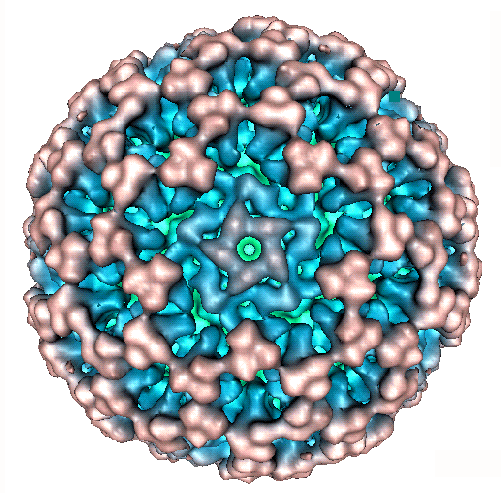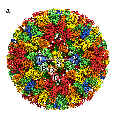 |
ReoID Phylogenetic sequence analysis and improved diagnostic assay systems for viruses of the family Reoviridae
Edited by Peter. P. C. Mertens and Houssam Attoui |
 |
| ||||||
|
Summary of First Coordination Meeting: June 7-8th 2001 Thessaloniki Greece
Phylogenetic sequence analysis and improved diagnostic assay systems for viruses of the family Reoviridae (Reo ID: contract No. QLK2-2000-00143)
. 7th June 2001
Maria welcomed everybody to Greece for the 1st co-ordination meeting of the EU funded Reoviruses project.
Talk 1: Introduction: Reoviridae and Orbivirus Classification Peter Mertens (project coordinator) then gave an introductory talk, representing an overview of the Reo 1 grant. There are currently three grants from the European Commission that are relevant to Bluetonge virus and involve the Institute for Animal Health at Pirbright.
Peter introduced the participating laboratories and briefly described their planned contribution to the project as a whole. He went on to explain how the project was designed to fit within the current research and knowledge concerning viruses of the family Reoviridae, with reference to the aquareoviruses, coltiviruses and orbiviruses, particularly bluetongue virus.
A number of specific areas were briefly discussed:
Talk 2: Sequence data currently available for the Reoviridae Nick Knowles presented an overview of sequence data that was already available for members of the family Reoviridae.
Talk 3 Alan Samuel described the work that he had already initiated at IAH Pirbright with help of a PhD student (Sushila Maan) . These studies had evaluated primers from published work (Wilson & Chase: Pritchard and Gould ) that had been designed for serotype specific RT-PCR amplification of BTV segment 2 from American and Australian isolates of BTV. When tested against reference strains of all 24 BTV serotypes from South Africa none of the primers gave false positive results with heterologous serotypes, indicating a high level of specificity. However, several of the primer sets failed to give cDNA products of the correct size with the homologous reference strain, indicating that further primer development and / or additional primer sets would be needed for reliable identification of several serotypes. The primers for BTV-2 did give product of the correct size with the reference strain.
Talk 4 Stefan Zientara presented a talk describing African Horse Sickness (AHS) serotype specific assay based on RT-PCR of genome segment 2 . He also talked about Bluetongue Virus (BTV) and its recent incursion into Corsica. The discussion included an analysis of how FMDV had spread from West Africa across the Saharan desert by the illegal movement of Zebu cattle could parallel what was happening with Bluetongue. It was agreed during discussions that it was important to get samples from Sardinia, as well as from Morocco and other African countries. Further sequence information and comparisons of BTV-2s was thought to be both timely and important. It was also thought that perhaps a joint FMDV/BTV publication could result.
Talk 5 Kiki Nomikou and Babis gave a talk on the results of PCR for segment 10 for the diagnosis of BTV. They showed that they had good results from samples from cell culture. This work was already in press in the Journal of Virological Methods. Stefan suggested that an RNA control in the PCR would be preferable to the β-Actin they were using. This led to a discussion during which Dr Mertens proposed that the group should agree on a s tandard control for diagnosis that could be shared between laboratories.
8th June 2001
BTV-epidemiology in the Mediterranean Basin: Not an endemic situation. Dr Mertens suggested that he would like to tie this project closely with that of Dr Philip Mellor. And perhaps they could have linked web-sites to disseminate and share information. It was also noted that Dr. Mellor sent his apologies for not attending the meeting
Talk 6 Dr Kiki Nomikou spoke about the current position with BTV in Greece. 1979: the 1st occurance of BTV-4 in Greece. 1980-1988: sero-surveillance carried out in Greece. 1991to1998 Greece was BTV free. 98, 99 2000 large and multiple outbreaks of BT in Greece.
Talk 7 Professor Orestis Papodoupolous spoke about the BTV epidemic in Greece. He suggested that the Vaccine Project should look at the current live attenuated vaccines and the problems they pose due to their potential for genome segment exchange (re-assortment) with other viruses in the field. It was suggested that viraemia can occur for up to 100 days in cattle. He also made the point that vaccines need to stop transmission in order to be effective.
Other viruses should be obtained from as many sources as possible to set-up a reference collection of virus isolates and a database of their sequences as resources for the molecular epidemiological studies of BTV. The sequences would be made available, via the dsRNA website, for use by interested laboratories.
Talk 8 Houssam Attoui presented a talk on the sequencing techniques that had been developed for the cloning of any dsRNA virus in the laboratory in Marseille. He spoke of the sequential segment subtraction method. Eyach viruses: Isolated from Nr Stuttgart and appear to be endemic in Rabbits.
It was agreed in discussions over coffee that at the next meeting the software that people would use for the phylogenetic analysis should be discussed so that there would be consistency of use between the participating laboratories.
Talk 9 Xavier de Lamballerie: Presented data on the St. Croix river virus. A discussion on the classification of viruses took place where it was discussed that Rota A=s and Rota B=s do not cluster very well together. It was agreed that the classification criteria had to be polythetic.
Talk 10 Paco Rodriguez: suggested that he should concentrate on expressing the proteins to Aquareoviruses and raising Mabs to those proteins. Xavier and Houssam should then concentrate on the sequencing studies.
Peter Mertens suggested a numeric way of classifying viruses rather than by species. This is to avoid confusion like the case of Grass Carp Virus and Golden Shiner Virus, which are the same virus.
Discussions Reoviridae: To work and obtain more complete reovirus genome sequences.
Orbiviruses: Other Orbiviruses should be sequenced. It was agreed that it would be desirable to obtain data on a representative of each species.
Seadornaviruses and coltiviruses: Houssam and Xavier are already sequencing representatives of the genus Seadornavirus. They said they were also interested in Coltivirus isolates from Asia if they could obtain them.
Aquareoviruses:. Paco said that his goal is to sequence a complete genome They will also sequence segment 2 & 10 of new viruses. They are collecting Aquareoviruses as a reference collection. It was agreed that resistance by people to send isolates is an obstacle. Offering authorship on a paper can sometimes alleviate this and was a practice that could be adopted.
Peter Mertens said there seemed to be very little interest in some of the Reoviruses ie Plant Reo=s and Rotaviruses. Nobody was keen to do this. People were also not keen to work on the scorpion, crab and bed bug type Reo=s.
Stefan bought the subject up of authorship. Perhaps putting data together to get publications would be good. Dr Mertens suggested that we got the data first, then looked at publications. He also said that the attitude of BBSRC (the parent research Council of IAH Pirbright) to publications was that if BBSRC funded scientists were co-authors, each collaborating group could take credit for the whole of jointly published work. Everyone agreed that this was desirable. The sequence database could go on a secure website so that participants in the project could have access to the data. Dr Mertens said he would establish this website, with appropriate username and passwords,
Bluetongue: BTV-2: Stefan said that he wished to work on BTV-2 serotype as it would be easier for him to get agreement for him to work on that serotype as it is of current interest. He suggested they work on segments 2, 6 & 3. Peter explained that IAH would also work on BTV-2 as one of the European types and it was agreed that the laboratories would exchange data and if possible publish jointly.
BTV -1 isolates from India. Peter said that to work initially towards a representative isolate from each serotype would be desirable. There are currently 10 serotypes for which there is no sequence data available for segment 2. To kickstart the molecular epidemiology studies Nick Knowles suggested to go for the serotype with the most available isolates or at least the most geographically diverse sample of isolates.
BTV - 4, 9 & 16: Kiki and Maria will seek to sequence the segment 2 of BTV serotypes 4, 9 & 16 because these are the types currently found in Greece and neighbouring regions. Dr Mertens said that Pirbright would also work on the European strains (4, 9 and 16) and would try to on provide sequences for segment 2 of other types that had not characterised (eg 5 and then 6). This was of course subject to the availability of isolates. He also suggested that participants compile lists of the isolates that they have available. This data should go onto the web-site so that the group can access the site for information.
BTV -1 isolates from India. Peter said that to work initially towards a representative isolate from each serotype would be desirable. There are currently 10 serotypes for which there is no sequence data available for segment 2. To kickstart the molecular epidemiology studies Nick Knowles suggested to go for the serotype with the most available isolates or at least the most geographically diverse sample of isolates.
EHD everyone should try and obtain isolates by asking any contacts they have in various countries. Pirbright will send RNA of all 24 reference strains to Greece. Joint publications are very desirable to all.
| ||||||||||||||||||||||||||||
|
|